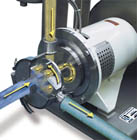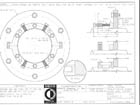
A cutaway shows dry ingredients (yellow) being sucked into a four-blade rotor stator, where it simultaneously mixes and is entrained with a liquid stream (blue). Source: Charles Ross & Son Co.
Game-changing technology is a rarity in any industry, particularly in fundamental food processes. On the other hand, high-shear mixers that break particles down to the micron level and pumps that blur the line between fluid movement and emulsification have demonstrated that mixing and blending is an area where technical innovation is happening with some frequency.
The point is being made again by Pursuit Dynamics plc, a UK firm that acquired the rights to a marine propulsion system in 2000 and has been adapting it for processing pumpable foods ever since. (See "Supersonic processing,"Food Engineering, p. 79, August 2005.) Mexico City's Grupo Jumex and an undisclosed US food manufacturer became the first North American licensees of Pursuit's "sonic shockwave technology" last fall, joining a handful of European food companies deploying the steam-driven system to cook, mix, pump, homogenize and emulsify a range of foods and beverages.
From the outside, the mixer looks like a simple metal tube, less than two feet long and with a bore ranging from 13 mm to 47 mm (almost 2 inches). Steam injected through a perpendicular port creates a vacuum inside the chamber, pulling product into the processing chamber at accelerating rates. The steam contracts and transfers energy to the product, beginning the pumping action that wells into a low-density shock wave across the bore diameter. By manipulating steam pressure and the wave's location, different effects are created: slow, gentle heating with large particulate, fast mixing for entrained powders and high-shear mode for homogenizing.

Stuart Rigby displays a fruit puree with particulate created in a kettle equipped with a sonic mixer. The mixing unit is immediately left of his bowl: product enters through the top orifice and passes through a zone fed by steam fed through piping on the diagonal lance. The 47 mm diameter unit can process up to 15,000 gallons an hour. Source: Pursuit Dynamics.
Recent trials were conducted in Ramsey, MN, where Anderson Dahlen Inc. built North America's first operating system incorporating the PDX unit. Four major food companies sent teams in February to conduct trials in the firm's 2,500-sq.-ft. test kitchen, with more tests scheduled in April and May. "The technical claims sound too good to be true; people have to see with their own ingredients just what the system is capable of doing," says Bob Knoll, Anderson Dahlen's project engineer. "One company sent a team of 14 from R&D, engineering and other disciplines."
One demonstration involved a sweet-and-sour sauce containing sugar, starches, gums, oils, spices and water. After those ingredients were entrained and emulsified, the unit shifted to gentle mode for heating and blending of solids. "The pineapple was still square, broccoli and peppers still looked nice, all in the space of four minutes for the entire sauce," Knoll recalls.
Speed and energy efficiency are important, but system advantages go deeper. Flavor release is intensified when fine granules are created, allowing a reduction in often-expensive ingredients. Temperature is less of a factor in starch activation. "You could go back to using native starch," Rigby says. Multi-stage processes can be simplified, eliminating both equipment and the potential for processing errors. "Some baby-food formulations have three stages, so there are three areas for screw-ups," he points out. "We're doing it in one pass."
Certification under 3A sanitary guidelines is pending.

The top half of Breddo Likwifier's water-cooled double seal is shown. The advanced design responds to manufacturers' demands for clean-in-place mixers. Source: American Ingredients Inc.
CIP seals
Innovation needn't be revolutionary to have a significant impact on plant operations. A case in point is a redesigned seal for high-shear mixers from American Ingredients' Breddo Likwifier division. To facilitate clean-in-place (CIP) sanitation, engineers recently designed a water-cooled double seal for bottom-entry mixers."The Achilles heal of bottom-entry agitation is the seal at the bottom," says Bill Wade, Breddo's equipment director. With a conventional seal, if product level in the tank drops too low, burn-on may occur, creating a clean-up challenge and potentially ruining the seal.
Minimal surface area reduces the opportunity for product to adhere to the impeller of Breddo's new seal. The seal is unitized with the impeller by compressing it into the impeller coupling. Springs that used to be exposed are now encapsulated, sealing out product without restricting spring movement. Instead of relying on product to cool the seal, water at approximately 10 psi flushes and lubricates it. The water flush helps prolong seal life by eliminating the abrasive effect of sugar and other ingredients on the seal's carbon face.
"For processors who have to pull the seal for cleaning at the end of every run, the new seal is a huge maintenance savings," notes Wade. "It's usually a two- or three-man job" to manually clean the tank. The potential for misaligning the reassembled seal exists, and "you run the risk of damaging the seal and scratching the No. 4 finish on the inside," he says. For those reasons, seal CIP is a significant improvement.
The first field application came at a high-volume ice cream plant where allergen control for new lines was a top priority. Throughput would have necessitated replacement of standard seals every two months. "After a year, there was little discernable wear," reports Wade. Mixers can be retrofitted with the new seal at Likwifier's Kansas City shop. "It's not inexpensive, but if the mixer is in good condition, it is cost effective," he says.
One-year useful life is the norm for the advanced seals designed by Woodex Bearing Company Inc., a Georgetown, ME, maker of custom-engineered shaft seals under the MECO name. "We make one-off and two-off seals," says Chief Engineer Paul Wehrle. Precision split and perfectly circular, Woodex's bearings and seals can run into five figures. On the other hand, clients who have had six-figure batches of carrageen and other valuable products rejected because packing glands failed and contaminated a batch have no difficulty calculating ROI.
Wehrle's seals use a driving elastomer in place of internal springs that can loosen, corrode or break. The driving elastomer is the seal's only interface with the shaft, and they accommodate significant radial shaft misalignment and shock loads. As the rotors wear, shims between the seal's two halves are removed, maintaining a tight fit.
While the engineering is sophisticated, the application is simple: "Just center and mount it square," Wehrle says. Over- and under-tightening is not an issue. At least 6 mm of total shaft run-out/misalignment capacity is built into all seals.

Precision engineered sanitary seals for mixers and blenders from MECO compensate for at least 6 mm of shaft run-out while maintaining seal integrity. Source: Woodex Bearing Company Inc.
Age of customization
With manufacturers clamoring for product-specific solutions, suppliers are undertaking redesigns that meet category trends. Coated meat products, particularly battered poultry, illustrate the point. For decades, the automatic batter circulation (ABC) mixing system from FMC FoodTech served this niche. Explosive sales growth in recent years placed a premium on greater batter consistency. The pressure transducer on ABC mixers, while superior to on-line measurements with hand instruments, could not respond to temperature changes and other variables as some food companies demanded. The solution was a mixer overhaul incorporating a Brookfield viscometer and a PLC feedback loop to keep batter viscosity within a few centipoises of set point without operator input."A single tuning-fork probe that is constantly vibrating extends into the batter and measures its sound waves," explains Engineering Manager Jim Ehret. "This technology greatly improves accuracy and provides constant monitoring." A 4-20 mA signal is relayed to a PLC, triggering automatic adjustments to the flow of water and dry mix into the tank and keeping viscosity within one percent of the target. Electronic sensors monitor batter level in the tank and dry mix in the hopper, alarming the operator as necessary.
The viscometer is incorporated in FMC's ProMix machine, which also underwent sanitary design improvements. Brute strength is less of a factor when manual replenishment of ingredients is required: whereas the hopper on the ABC mixer was 5-ft. tall, the new unit is only 40 inches above the floor. The tank itself holds 3,000 lbs. of batter, half again as much as the ABC machine.
While ProMix focuses on batter, Hauppauge, NY-based Charles Ross & Son Co. had the bakery segment in mind when it developed the solid-liquid injection manifold (SLIM), which is proving to be one of Ross's most successful mixers, particularly for in-line applications. SLIM overcomes clogging problems with gums by accomplishing mixing and shear in the unit's rotor stator, eliminating the need for an upstream inductor. The rotor stator generates enough suction to pull dry ingredients in without pumping, simplifying operation and lowering maintenance and capital costs.
Mercury in a vacuum will rise to 30 inches, according to Doug Cohen, Ross' vice president-technical services. The suction from the rotor stator will raise mercury 25 inches. "This cuts out dumping bags into an open vat and raising dust while trying to blend," Cohen says. "It also gives processors the ability to add and disperse powders on the fly." Introduced three years ago, the machine continues to evolve, with improved rotor stator geometry and a close-coupling setup that shrinks the machine's length by 20 inches.
Bigger changes are coming from Invensys APV, which is retiring its Liquiverter line in favor of Flexi-Mix, a direct-drive machine with variable frequency controls for multi-speed operation. Gone are the angled gearboxes and belt drives of the single-speed Liquiverter, according to Jim LeClair, technical director at APV's Lake Mills, WI, facility. Available since 2003 in Europe, the batch mixers recently gained 3A certification in preparation for US rollout.
High-speed AC motors tied to a control panel mean fewer moving parts and no gearbox, says LeClair. "Based on frequency, you could operate this mixer as slow as 30 RPMs," he adds. Fewer seals are required, and the ones remaining have smaller surface areas and fewer dirt-collection points. Hygiene is improved with CIP design.
Rotor stator design has advanced to high science in an academic-industry consortium under the auspices of Professor Richard Calabrese, a chemical engineer at the University of Maryland. Consortium members include Procter & Gamble, DuPont, and Silverson Machines, SPX/Lightnin and IKA Works Inc., three high-tech manufacturers who are ramping up high-shear mixing to warp speed.
"High-shear mixing is still black box technology in that many of the things you thought were true are only half true," explains Scott Anderson, technical services manager at Wilmington, NC-based IKA Works. Laser Doppler, computational fluid dynamics and other tools are being applied by consortium researchers to model the dynamics of high-shear mixers. The computations are complex: networked computers take days to calculate the optimal rotor stator design for a specific processing challenge, Anderson says. As databases are built and "computer and software catch up, we ultimately will have formulas for the predicted outcome in size reduction, droplet dimension and other outcomes in a commercial scale up," he says.
Consortium-driven improvements are incremental rather than dramatic. A Eureka moment isn't likely, but the long-term payback will be significant for mixing and blending, continuing a trend already evident on many fronts.
For more information:
Bob Knoll, Anderson Dahlen Inc., 763-852-4703, knor@andersondahlen.com
Bill Wade, Breddo Likwifier, 800-669-4092, bwade@americaningredients.com
Doug Cohen, Charles Ross & Son Co., 631-234-0500, dcohen@mixers.com
Jim Ehret, FMC FoodTech, 419-626-0304
Scott Anderson, IKA Works Inc., 910-452-7059
Jim LeClair, Invensys APV, 920-648-1512, jim.leclair@invensys.com
Leo Cochrane, Pursuit Dynamics, 203-202-2128
Paul Wehrle, Woodex Bearing Company Inc., 800-526-8800, bird@mecoseal.com